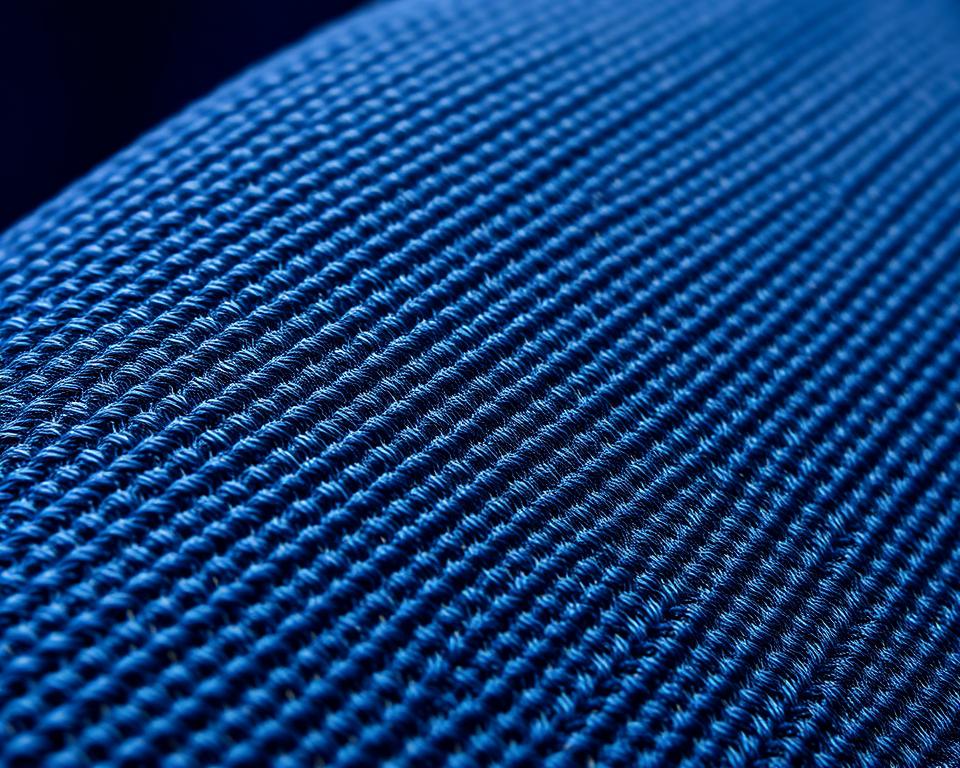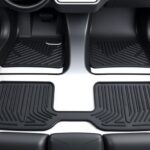Your Ultimate Selvedge Denim Material Handbook
A single pair of vintage Levi’s 501s from the 1940s recently sold for $87,400 at auction. What caused these jeans to outprice a luxury vehicle? The answer lies in their selvedge denim material construction.
This premium denim represents more than just fabric. It connects us to a time when James Dean wore his 501s in Rebel Without a Cause and Marlon Brando defined cool in The Wild One. Those pop culture legends weren’t merely clad in denim. They wore black selvedge denim fabric wholesale crafted on vintage shuttle looms.
Craft denim derives its title from the self-finished perimeters that avert fraying. The word “selvedge” fuses “self” and “edge” to depict this singular weaving approach. In contrast to mass-made denim, every yard of selvedge denim material demands time and craftsmanship.
Its feel conveys a history through faint irregularities and innate variations. Each iteration gains personality as the indigo lightens. This individual progression renders heritage denim exceptional to collectors and style aficionados alike.
Numerous people assume high-end denim endures beyond ordinary jeans. The fact is somewhat more complex. Selvedge crafting produces lovely material with tidy edges and robust texture. Yet durability hinges on cotton grade and weight, rather than solely on weaving method. What sets artisanal denim apart is its ability to age gracefully and develop unique fade patterns over time.
Understanding Selvedge Denim Material
Selvedge denim cloth stands apart from standard denim because of its special build and polished borders. It’s titled after its “self-edge,” a closely woven strip that blocks fraying. This top-tier fabric embodies a commitment to slow fashion and classic artisanry, distinguishing it from factory-produced denim.

The Meaning Behind Self-Edge Construction
The term “selvedge” is a blend of “self” and “edge,” describing fabric with a clean, finished border. This narrow selvage runs along both sides, removing the requirement for added finishing. Old-school mills craft it at roughly 30–32 inches wide, unlike contemporary denim’s 60-inch span.
Why Shuttle Looms Yield Distinct Fabric Edges
Denim from shuttle looms derives its persona from antique weaving machines running at reduced speeds. These looms weave a single weft yarn across the warp threads in one motion. This process yields:
- Natural texture variations called slubs
- A gentler hand-feel compared to contemporary denim
- Firmly locked edges that avoid fraying
- Authentic irregularities cherished by denim enthusiasts
Difference Between Selvedge and Standard Denim
Standard denim is made on projectile looms that shoot weft yarns across wider fabric. That technique produces loose edge threads that must be overlocked to avoid fraying. Selvedge denim fabric, on the other hand, takes more time to produce. It delivers enhanced durability and a distinct look, warranting its premium price.
The Heritage and History of Shuttle-Loomed Denim
Heritage denim’s story began in 19th-century American textile mills. Shuttle looms were key, weaving fabric with tightly woven edges to prevent fraying. This method produced indigo-dyed denim at a slow, meticulous pace, ensuring each yard was crafted with care. Its slender width evolved into a trademark of artisan denim manufacture.
From 1800s American Mills to Modern Revival
For more than 100 years, U.S. mills depended on shuttle looms. Labels like Cone Mills and White Oak delivered high-end denim to workwear firms. Come the 1970s, speedier projectile looms dominated, supplanting most shuttle setups. This shift was driven by the need for cheaper, mass-produced jeans. Numerous old mills shuttered or updated, letting antique looms sit idle.
The Rise of Japanese Selvedge Excellence
In the 1980s, Japanese manufacturers revived American shuttle looms. The Osaka Five labels headed this resurgence:
- Studio D’Artisan
- Evisu
- Fullcount
- Warehouse
- Denime
Those firms blended U.S. retro flair with Japanese exactness. They researched antique Levi’s templates, reproducing classic indigo denim textures. By 2000, Japanese makers had overtaken the global artisan denim market.
The Importance of Traditional Weaving Today
Shuttle looms yield distinct cloth traits that contemporary machines cannot replicate. This slower method fosters subtle irregularities and fuller indigo soak. Hardcore denim fans treasure these quirks as proof of real craftsmanship.
| Shuttle Loom Features | Modern Loom Features |
|---|---|
| 29-31 inch fabric width | 60+ inch fabric width |
| 3-4 yards per hour | 15-20 yards per hour |
| Natural irregularities | Uniform texture |
| Self-finished edges | Cut edges requiring overlocking |
Making Premium Denim on Antique Looms
Premium denim production kicks off with the steady rhythm of antique shuttle looms. These devices vary greatly from today’s looms. They pass yarn across the entire width in one thread, sealing edges without extra finishing. This method ensures selvedge denim has a clean, non-fraying edge.
Antique looms run slowly, churning out only 5–6 meters of slub denim per day. This is in stark contrast to modern machines, which can weave 200 meters. The unhurried pace advantages the yarn via:
- Lower tension in threads produces a plusher hand
- Organic irregularities stay put, granting unique texture
- Uneven surfaces lead to distinctive fading patterns
- Thin widths (about 29–32 inches) minimize trimming waste
Manning these age-old looms calls for seasoned artisans. Mill workers adjust tension, monitor rhythm, and perform repairs. Each loom has its own unique character. Many were built in the 1920s and require know-how passed through the ages. This tactile method turns shuttle-loomed denim into an authentic artisan good.
The slender width of unwashed denim from classic looms provides practical perks. Denim craftsmen can employ the finished edge as the outseam, cutting waste. This highlights the material’s genuine build. Every bolt carries history, with slight quirks that mass output cannot match.
Understanding Raw Denim vs Selvedge Differences
Numerous denim lovers conflate raw denim with selvedge denim. This mix-up appears during premium jean hunts. The fact is they denote separate facets of denim creation. Recognizing the distinction empowers you to choose wisely and admire each type’s special qualities.
Why Not All Selvedge Is Raw
Selvedge refers to the weaving method on vintage shuttle looms, creating self-finished edges. Raw denim means unwashed fabric straight from the mill. A selvadge raw denim fabric wholesaler might offer both washed and unwashed options. Brands like Naked & Famous produce selvedge jeans, sometimes pre-washed or with stretch.
The weaving technique remains the same. But finishing alters the material’s hand-feel and aesthetic completely.
Washed and Unwashed Denim Compared
All denim starts as dry denim prior to wash. Factories make both regular and selvedge variants in unwashed form. Key contrasts include:
- Raw denim forms distinct fade lines with wear
- Washed denim delivers immediate softness and size consistency
- Sanforized raw shrinks little after initial laundering
- Unsanforized versions shrink significantly when soaked
Clearing Up Denim Myths
Not all raw denim comes from shuttle looms. Contemporary projectile looms likewise churn out unwashed textile. Their appeal converges since consumers prize longevity, customization, and artistry in both selvedge and raw denim. Each style lures denim aficionados ready to devote time for bespoke fades.
How to Identify Real Selvedge Denim
When hunting for herringbone selvedge denim fabric, identifying authentic selvedge denim is crucial. It sets you apart from ordinary buyers. Real selvedge denim has unique traits that set it apart from regular denim. Understanding these features ensures you’re investing in authentic premium denim.
Finding the Selvedge ID
Easiest method to confirm selvedge denim? Inspect the outseam. Turn up the cuff and look at the seam along the outside of the leg. Real selvedge denim shows a neat, sealed edge with dyed yarns interwoven. This self-finished edge eliminates the need for overlocking stitches found on regular denim.
Rolling your cuffs unveils the selvedge ID, giving your outfit a signature detail. The colored edge yarns run continuously down the outseam, creating that signature look denim enthusiasts adore. By contrast, non-selvedge jeans sport cut edges bound by serger stitches to stop fraying.
Identifying High-Quality Construction
Quality premium denim is evident through several construction details:
- Dense, uniform weaving free of stray threads
- Neat selvedge borders lacking extra seams
- Uniform edge thread color along the outseam
- Dense fabric weight typical of shuttle-loom production
What Makes Rainbow Selvedge and Redline Special
Rainbow selvedge denim features multiple colored yarns in the selvedge ID, creating a unique multicolor edge. Redline selvedge, the renowned style, features red edge yarns and originates from heritage American mills. These unique selvedge forms carry premium prices thanks to their scarcity and aesthetic allure. Most brands proudly highlight these features in product descriptions, making authentic heritage denim easier to identify.
Why Artisanal Denim Commands Premium Prices
The cost of artisanal denim often shocks newcomers. A set of selvedge jeans may run three to five times higher than standard jeans.
Grasping the reasons for these prices uncovers the real worth of high-end denim.
Shuttle looms run far more slowly than contemporary looms. While mass-production looms yield fabric swiftly, heritage shuttle looms turn out just 1–2 meters each hour. This slow process means a single roll of heritage denim takes days, not hours.
The slender breadth of selvedge fabric hikes up costs. As opposed to 60-inch standard denim, shuttle-loom premium denim is merely 28–32 inches across. This narrower width requires more careful cutting and planning to use the fabric efficiently.
Craft denim making happens in small runs. Suppliers like Okayama’s White Oak and Kuroki emphasize quality rather than scale. They rely on veteran craftsmen who supervise every phase:
- Hand-checking yarn tension
- Adjusting loom settings for each fabric type
- Inspecting every meter for flaws
- Managing rope-dyeing processes that take weeks
These denim makers view their craft as art. They experiment with unique yarns and perfect indigo-dyeing recipes passed down through generations. Buying heritage denim sustains mills upholding textile customs and craftspeople passionate about their trade.
Wholesale Choices for Black Selvedge Denim Fabric
Premium denim availability now reaches beyond Japan’s heritage mills. American brands now compete, providing a wide range of black selvedge denim fabric wholesale. To find the best supplier, it’s essential to understand quality markers and the origins of authentic materials.
How to Choose Top Suppliers and Mills
Top vendors underscore traditional weaving and genuine devotion to craft. When seeking a selvedge raw denim wholesale source, pick mills operating antique shuttle looms. They provide comprehensive fabric details: weight, weave style, and dye processes.
Gold Selvedge Denim Fabric Manufacturers to Know
Gold selvedge denim fabric manufacturers focus on premium colored ID lines, adding luxury to jeans. Premier producers weave these specialty textiles in constrained runs, luring boutique makers. The gold-ID thread bestows an exclusive trim, differentiating them from usual choices.
How to Procure Nep Denim and Unique Weaves
Specialty fabrics like nep denim need specific sourcing channels. Nep denim shows deliberate specks for standout aesthetics. Dealing straight with manufacturers secures supply of these specialty textiles.
| Fabric Type | Minimum Order | Lead Time | Price Range per Yard |
|---|---|---|---|
| Black Selvedge | 500 yards | 6-8 weeks | $12-18 |
| Gold ID Selvedge | 300 yards | 8-10 weeks | $15-22 |
| Nep Denim | 400 yards | 10-12 weeks | $14-20 |
Selvedge Styles and Variants
The world of selvedge denim fabric goes beyond basic indigo. Today, mills create a wide range of textures and patterns. These demonstrate shuttle-loom weaving’s flexibility. Ranging from faint surface quirks to striking patterns, they deliver one-of-a-kind personality that evolves elegantly with use.
Exploring Slub Denim Texture
Slub denim’s unique textured surface originates from thick-thin yarn variations. They feature thick and thin zones, yielding an organically varied fabric face. On shuttle looms, they create slub-textured selvedge denim with random fade patterns.
Each slub denim jean yields its own one-off wear pattern. The raised slubs fade differently than the flat parts, ensuring no two pairs look alike.
Herringbone Selvedge Traits
Herringbone selvedge denim fabric has a distinctive zigzag pattern, resembling fish bones. It yields slanted lines alternating direction at consistent spaces. This design enhances appearance and amps up the material’s toughness.
Labels such as Iron Heart and The Strike Gold often employ this weave in their high-end lines.
Understanding Striped Denim & Specialty Weaves
Striped denim fabric incorporates contrasting yarns to create vertical or horizontal lines. Mills achieve these patterns by alternating different colored threads during weaving. Notable variants include:
- Hickory stripe with alternating indigo and white
- Railroad stripe featuring thin pinstripes
- Wabash stripe with printed dots over stripes
| Fabric Type | Visual Pattern | Fade Characteristics |
|---|---|---|
| Slub Denim | Bumpy, irregular surface | High contrast, uneven fading |
| Herringbone | Zigzag diagonal lines | Subtle vertical streaking |
| Striped Denim | Alternating color bands | Pattern remains visible after fading |
Caring for Your Heritage Denim Investment
Your heritage denim requires special care to develop its unique character. Unlike standard jeans, raw and dry denim morph through use. They craft individual fade narratives reflecting your life.
The first few weeks with artisanal denim can feel stiff and uncomfortable. This experience is expected. It takes time for the cloth to soften and contour your form. Some denim enthusiasts speed up this process by wearing their jeans in the shower or doing squats while damp. Others choose a slower, natural wear-in routine.
Raw denim shows top fade patterns when you postpone laundering. The oils from your skin and friction from daily wear create whiskers behind the knees and honeycombs at the back. Many wearers wait six months for the first wash, and some even a year. This patience rewards you with high-contrast fades unique to your movement patterns.
At wash time for dry denim, invert and launder in cold water. Skip the spin cycle and hang dry away from direct sunlight. Some prefer hand washing in the bathtub with gentle detergent. Steer clear of hot water and tumble drying, which may shrink and dull fades.
Your denim keeps appreciating as you care for it properly. Every wear layers character, ensuring your jeans are uniquely yours. The firm break-in becomes a flexible second skin mirroring your daily life.
Where You Can Purchase Quality Indigo Denim Now
The revival of selvedge denim has unlocked new paths for denim lovers. Large chains now offer indigo denim, while niche shops continue premium slow-fashion offerings. This helps buyers locate real selvedge choices across price ranges for any budget or taste.
Levi’s sells its 501 Original Fit Selvedge for $148, bringing heritage craft to more people. Uniqlo offers its Selvedge Straight at $50, striking a balance between style and price. For upscale choices, Buck Mason presents Japanese Loom State Selvedge Full-Saddle Jeans at $248. Iron Heart takes premium denim to the next level with their 634s-18 Vintage Denim Jeans, priced at $385, available through Self Edge stores.
U.S. labels such as Todd Snyder and Buck Mason now rival Japanese experts in the selvedge arena. They understand that heritage weaving and top quality drive slow fashion. Whether shopping online or in physical stores, quality indigo-dyed denim is more accessible than ever to American consumers who cherish authentic craftsmanship.

